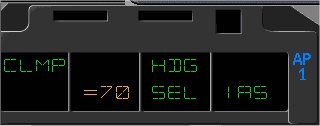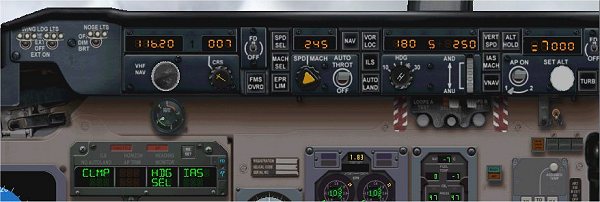7. DESCEND.VNAV MODE.
A crossing altitude, end of descent (E/D), shall at some point along track be entered by the flight crew. When E/D point has been entered, the FMS will compute the top of descent (T/D) point taking into account distance along track and wind component. The ECON descent profile is an idle power descent where the speed varies only with cost
index. The ECON descent profile gives maximum total economy with the selected cost index. VERT SPEED/SPD SELECT MODE. 
This procedure can be used for descents where the pilot desires to control the descent rate and keep the descent speed constant, e.g when commencing descent before the FMS computed T/D point is reached. This procedure is strongly recommended for descent below MSA (Minimum Sector Altitude) + 2000ft. This mode is often initially used to when descending from high flight levels. In VNAV mode the rate of descent will be high. Start descending in VERT SPEED mode 15-20NM before T/D with rate of 1500ft/min and speed .76/300kts. When reaching the "GP" change to VNAV or IAS HOLD mode. This maintains a good passenger comfort during the initial part of the descent. IAS/MACH HOLD MODE. 
This procedure can be used for descent where the pilot desires to control the descent speed by pitch attitude with throttles at idle, e.g when for any reason the FMS computed T/D point has been passed.
We have received our descend clearance down to FL100. After passing the T/D the ND will show the relative glidepath (the diamond on the right side). There is also a green arc on the ND where we will reach FL100. This is how the TARP and ND would look if we used VNAV descend. To do that we would have to enter 250kts as our speed on the FMC DES page. We normally donīt do that and instead use the mode IAS HOLD. Move the thumb wheel very carefully and establish the aircraft in a descend with 1500ft/min. The A/T will still be in SPEED mode and retard the throttles. Now, we change mode to IAS HOLD instead. This mode is an Autopilot mode. The throttles will go into CLMP (Climb) mode. The A/T are still engaged but the servos will disconnected. We move the throttles manually to idle thrust. The AP will know keep a speed of 250kts. The next call from the ATC hands us over to the Copenhagen approach.
On the ND there are a green dotted line (our present heading of 180). The magenta line towards 210 is the original Sveda 1C arrival.
This is our Glareshield at this stage. Time for the approach checklist. Since we have a temperature on ground of 5° and a dewpoint also 5° we should use engine anti-ice. When approaching top of clouds we should also switch on the airfoil anti-ice.
From the AOM we can read: During descent with engines at idle power and airfoil anti-ice on, the L/R ICE PROT TEMP LOW caution and AIRFL ICE PRESS ABNML caution may come on. This condition is acceptable to preheat the wings, but when actual icing is experienced it may be necessary to increase power up to 1.2 EPR to ensure that an adequate supply of hot air is available for the ice protection systems. ICE PROT TEMP LOW and AIRFL ICE PRESS ABNML cautions shall be off.
|
 This procedure is recommended to be used during the initial descent from Top-of-Descent until
ATC instructions make use of FMS NAV/VNAV functions unpractical. The procedure utilizes the
ability of the FMS to control the autopilot and autothrottle to maintain a preselected
descent path including speed and altitude constraints. The default descent profile is based
on ECON speed or pilot edited cruise speed from top of descent down to 10 000ft and then
240kt to the end of descent altitude.
This procedure is recommended to be used during the initial descent from Top-of-Descent until
ATC instructions make use of FMS NAV/VNAV functions unpractical. The procedure utilizes the
ability of the FMS to control the autopilot and autothrottle to maintain a preselected
descent path including speed and altitude constraints. The default descent profile is based
on ECON speed or pilot edited cruise speed from top of descent down to 10 000ft and then
240kt to the end of descent altitude.



